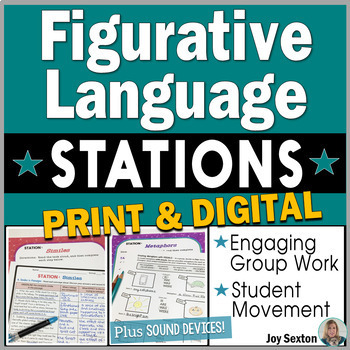Figurative Language STATIONS - Group Activities - Print & DIGITAL
- Zip
- Google Apps™

What educators are saying
Description
Figurative Language Stations with Task Cards: Would you like your students more clear on figurative language and sound devices? Motivate them with this must-have creative STATION work! Now includes a DIGITAL version! You get EIGHT different stations with task cards and inviting student handouts for each.
Students identify and analyze figurative language, and then brainstorm to apply their knowledge in imaginative ways. Clear and specific teacher guidelines are provided to make set up and grading quick and easy. Great for differentiation—you choose the stations that best fit your students’ needs.
The DIGITAL version offers colorful, nicely designed slides that allow students to type their responses into text boxes.
To access the DIGITAL version of this resource, you will find:
---a PDF in the zip file containing digital links for each part of the resource
---directions for uploading the resources and using them with students
With both print-and-go AND digital versions, you'll be equipped for all teaching situations!
The EIGHT STATION TOPICS are:
1. Similes
2. Metaphors
3. Personification
4. Hyperbole
5. Idioms
6. Alliteration (sound device)
7. Onomatopoeia (sound device)
8. Repetition ( sound device/literary technique)
************************************************************************************************
From teachers who have used this resource:
-- "Loved it! This is a great resource to have. My students loved it and were very engaged in the lesson."
-- "I used this lesson with my first formal observation. It was a hit! The kids loved it, and the principal was impressed!"
-- "Kept the kids engaged!"
-- "I LOVED this for my class. They were challenging but fun for the kids."
-- "SO great for review before state testing!"
************************************************************************************************
This resource contains:
1. TASK CARDS – Eight colorful task cards, each clearly outlining the specific group task and steps for completion. Students read the task card together when they assemble at the station.
2. STUDENT HANDOUTS (16 pages) – The 2-sided handouts are creatively designed and align with the station task cards so students can get right into their activity and begin discussing and delving into the topic.
3. FIGURATIVE LANGUAGE REFERENCE GUIDE – An attractive 2-sided reference sheet for each station with terms, definitions, and examples.
4. SIGNS FOR EACH STATION – Eight colorful signs that match the task cards - can be posted by each station to guide students to their areas.
5. GRADING RUBRIC – A 4-point Grading Rubric is included for your convenience. The rubric describes qualities of student work on four levels with space for you to assign your own grade or number of points.
6. ANSWER KEY – An answer key is provided for all student pages that require common answers (such as passages with questions).
7. A PDF WITH DIGITAL LINKS - The digital versions of each resource are provided by links on a PDF along with directions for easy access.
8. TEACHER GUIDELINES – Specific guidelines for implementing the station work offer suggestions and tips for getting the most out of this resource. Includes CCSS.
If you are looking for exciting group activities before or during a poetry unit, or any literature unit, grab this resource! Your students will definitely become more knowledgeable on figurative language and sound devices after experiencing these stations. Students enjoy movement and group work, and they retain their knowledge best when actively engaged.
Please open the PREVIEW!
Thanks --Joy
You may also like:
Non-Fiction Stations for ANY Informational Text
Mentor Sentence Stations - Group Writing Activities with Mentor Sentences
TASK CARDS for BETTER WRITING: Sentence Fragments
TASK CARDS for BETTER WRITING: Run-On Sentences
TASK CARDS for BETTER WRITING: Verb Tense Consistency
TASK CARDS for BETTER WRITING: Repetitive Wording
ELA Assessment and Test Review MINI-BOOK - Grades 6-7-8
---Yes! Join my list to receive Teaching Tips, New Product Updates, and FREEBIES from Joy





